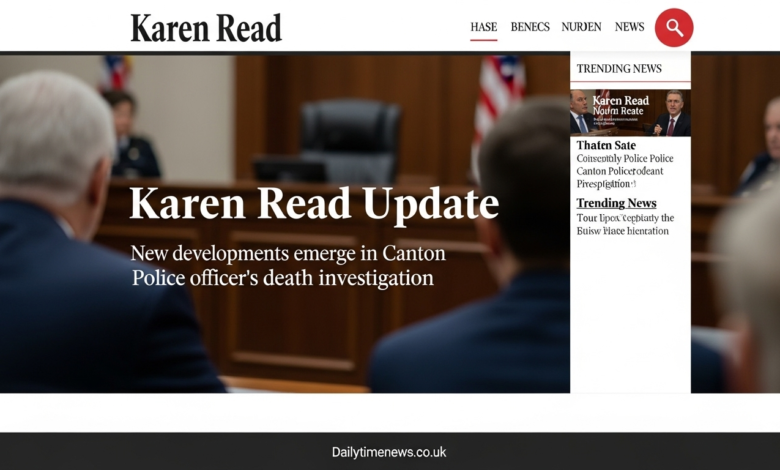Shocking Karen Read Update: Latest Trial Developments Revealed

Introduction
You’ve probably been following the Karen Read case, and if you’re here, you want to know what’s happening right now. This Massachusetts murder case has taken more twists and turns than anyone expected. The story of a Boston police officer found dead in the snow and his girlfriend accused of killing him has sparked nationwide attention.
The latest Karen Read update brings significant developments that could change everything. From new evidence to legal maneuvers, this case continues to divide public opinion. Some people believe Karen is innocent, while others think justice must be served. Either way, the facts are complicated, and the legal battle is far from over.
In this article, you’ll discover the newest information about the case, the evidence being presented, and what experts are saying about the trial. We’ll break down the complex details into clear, understandable information so you can follow along with this gripping legal drama.
Who Is Karen Read and What Happened?
Before diving into the update, let’s quickly recap the basics. Karen Read is a former adjunct professor accused of killing her boyfriend, Boston Police Officer John O’Keefe, in January 2022. Prosecutors claim she hit him with her SUV and left him to die in a snowstorm outside a home in Canton, Massachusetts.
The defense tells a completely different story. They argue that Karen is being framed and that John O’Keefe was actually killed inside the house during a fight. According to her lawyers, corrupt police officers and their friends are covering up what really happened.
This case isn’t just about guilt or innocence anymore. It’s become a referendum on police accountability, small-town politics, and whether the justice system works fairly for everyone.
The Latest Karen Read Update: Trial Postponed Again
The most significant recent Karen Read update involves yet another delay in her trial. Originally scheduled for a retrial in early 2025, the case has been pushed back multiple times. Legal experts weren’t surprised by this development, given the complexity and the amount of evidence both sides are reviewing.
Judge Beverly Cannone granted the postponement after defense attorneys requested more time to prepare. They cited new evidence and the need to interview additional witnesses. The prosecution didn’t object strongly, which raised some eyebrows among courtroom observers.
The delay means Karen Read remains free on bail. She continues to maintain her innocence publicly and has developed a strong following of supporters who believe she’s a victim of a conspiracy. These supporters, often called “turtles” after a nickname related to the case, show up at court hearings wearing pink and holding signs proclaiming her innocence.
New Evidence That Could Change Everything
Perhaps the most explosive part of this Karen Read update involves new forensic evidence. The defense team has been working with independent experts who challenge the prosecution’s version of events.
One major piece of evidence involves John O’Keefe’s injuries. Defense experts argue that his wounds are inconsistent with being hit by a vehicle. They point to specific injuries that they say look more like they came from a fight or an attack by a dog. This matters because one of the homeowners where John’s body was found owned a German Shepherd.
Cell phone data has also become crucial. Forensic analysts examined location data, text messages, and deleted communications from multiple people involved in the case. Some of this data, according to the defense, was either ignored or mishandled by investigators.
Additionally, there are questions about the investigation itself. The defense claims that key evidence was destroyed or “lost” by police. This includes John O’Keefe’s phone and certain pieces of Karen’s vehicle that might have proven whether it actually struck someone.
The Mistrial and What It Meant
You might remember that Karen Read’s first trial ended in a mistrial in July 2024. The jury deliberated for days but couldn’t reach a unanimous verdict. This was a significant moment that shifted momentum in the case.
After the mistrial, several jurors spoke publicly, which is unusual. Some said they had actually reached consensus on some charges. According to these jurors, the majority believed Karen was not guilty of second-degree murder, the most serious charge. However, the judge didn’t allow them to report partial verdicts, leading to frustration.
This revelation sparked immediate legal action. Karen’s defense team filed motions arguing that she couldn’t be retried on charges where the jury had reached agreement. This legal principle, called double jeopardy, prevents someone from being tried twice for the same crime after an acquittal.
The prosecution strongly disputed these claims. They argued that no official verdict was recorded, so double jeopardy doesn’t apply. This debate became a major focus of pre-trial hearings and remains unresolved as part of the current Karen Read update.
Public Opinion and Social Media Frenzy
This case has exploded on social media in ways few criminal trials have. TikTok videos, YouTube analysis, and Facebook groups dedicated to the case have millions of followers. Many of these supporters firmly believe Karen is innocent and being railroaded by corrupt officials.
The “Free Karen Read” movement has organized rallies, fundraisers, and awareness campaigns. Supporters wear merchandise, attend every court hearing, and flood social media with hashtags. Some have even investigated the case themselves, finding information they believe supports Karen’s innocence.
Not everyone agrees, of course. Critics say the social media frenzy is turning a serious murder case into entertainment. They worry that public pressure might influence the legal process or intimidate witnesses.
Legal experts have mixed opinions about this phenomenon. Some say public scrutiny helps keep the justice system honest. Others worry that trial by social media undermines the careful, evidence-based process that courts are supposed to follow.

Key Players in the Case
Understanding this Karen Read update requires knowing who the major players are. Besides Karen herself, several people have become central to the story.
The Albert Family: Brian Albert, a Boston police officer, owned the home where John’s body was found. His family members were inside that night. The defense suggests they know more than they’re saying.
Brian Higgins: An ATF agent who exchanged flirty texts with Karen. The defense has questioned his involvement and whether jealousy played a role.
Jennifer McCabe: A friend who was with Karen that night. Phone records show she searched “how long to die in cold” hours before John’s body was found, according to the defense. She denies this timing.
The Prosecutors: The Norfolk County District Attorney’s office is handling the case. They’ve faced criticism for their investigation but maintain they have strong evidence of Karen’s guilt.
The Defense Team: Alan Jackson and David Yannetti are experienced attorneys who’ve turned this into a battle against what they call a corrupt system.
What the Prosecution Claims
According to prosecutors, the evidence against Karen is clear. They say she was drinking heavily the night John died. After an argument, she drove erratically and struck him with her Lexus SUV, then left the scene.
They point to damage on her vehicle that they claim is consistent with hitting a person. Pieces of her taillight were found near John’s body. Additionally, witnesses heard her say “I hit him” and similar statements, which prosecutors argue are confessions.
The prosecution also emphasizes that Karen and John had a troubled relationship. They’d been arguing about their future together. This, combined with alcohol, led to a tragic and violent outcome, according to their theory.
From the prosecution’s perspective, the defense conspiracy theory is far-fetched. They say there’s no credible evidence of a cover-up, just a defense team creating reasonable doubt through wild accusations.
What the Defense Argues
The defense presents a completely different narrative. They claim John O’Keefe went inside the Albert home and was killed there during an altercation. His body was then moved outside to frame Karen.
Several factors support this theory, according to defense attorneys. John’s injuries don’t match a vehicle strike. There was no major damage to Karen’s SUV consistent with hitting a person. And the investigation was shockingly sloppy, with evidence mishandled or destroyed.
The defense also points to suspicious behavior by key witnesses. Google searches about hypothermia before the body was found. Deleted text messages. Home renovations at the Albert house shortly after the incident. A family dog that was rehomed quickly.
They’ve also raised questions about relationships between investigators, witnesses, and prosecutors. Some of these people knew each other socially, which the defense argues created bias and enabled a cover-up.
Most importantly, the defense insists that the physical evidence simply doesn’t support the prosecution’s story. Their experts have testified that John’s injuries came from a fight and possibly a dog attack, not a vehicle collision.
Expert Testimony and Forensic Battles
Much of this case comes down to dueling experts. Both sides have presented forensic specialists who reach opposite conclusions from the same evidence.
Defense biomechanical engineers say the physics don’t work for Karen’s SUV to have caused John’s injuries. They’ve created models and simulations showing that a vehicle strike would have caused different trauma patterns.
Medical examiners disagree on the cause of death. The state’s expert ruled it a homicide caused by vehicle strike. Defense experts say the injuries indicate assault and animal attack.
Accident reconstruction specialists have examined Karen’s vehicle, the scene, and weather conditions. Again, they reach different conclusions about what happened that night.
For you as someone following the case, these technical battles can be confusing. The key takeaway is that forensic evidence isn’t always as clear-cut as TV shows suggest. Experts can genuinely interpret the same data differently.
The Role of Corruption Allegations
A major element of the latest Karen Read update involves ongoing allegations of corruption. The defense hasn’t just claimed Karen is innocent. They’ve accused specific police officers and officials of criminal conduct.
These are serious allegations that go beyond typical defense strategies. They’ve accused investigators of planting evidence, destroying exculpatory material, and coordinating their stories. Some accusations involve witness intimidation and perjury.
The accused officials have denied everything. They say they conducted a thorough, professional investigation. The corruption narrative, they claim, is a desperate defense tactic.
Federal authorities have reportedly looked into some aspects of the case. However, no charges have been filed against any officials as of this update. Whether that changes remains to be seen.
What Happens Next?
So where does the case go from here? The retrial is currently scheduled for later in 2025, though that date could change again. Before then, several legal issues need resolution.
The double jeopardy question is huge. If the judge rules that Karen can’t be retried on some charges, it significantly weakens the prosecution’s case. This decision could come in the next few months.
Additional evidence continues to emerge. Both sides are conducting investigations and interviewing witnesses. Some of this information might not become public until trial.
Plea negotiations are always possible, though neither side has indicated interest. Karen has consistently rejected any deal that involves admitting guilt. She wants complete vindication.
Public interest shows no signs of fading. Every hearing draws crowds and media attention. The eventual trial will likely be one of the most watched in recent Massachusetts history.
Why This Case Matters Beyond Karen Read
This case has implications far beyond one person’s guilt or innocence. It raises important questions about how we investigate deaths, especially when police officers are involved.
If the defense corruption allegations have merit, it exposes serious problems in law enforcement accountability. Can officers fairly investigate incidents involving their friends and colleagues? Should there be automatic outside oversight in such cases?
The case also highlights how social media has changed criminal justice. Public opinion can now mobilize quickly and powerfully. Is this a good check on the system or a dangerous interference?
Additionally, the case shows gaps in forensic science reliability. When experts disagree completely, how should juries decide? What standards should apply to scientific testimony?
These questions matter whether you think Karen is guilty or innocent. The issues raised will affect how similar cases are handled for years to come.
How Supporters and Critics View the Case
The divide between Karen’s supporters and critics couldn’t be wider. Supporters see a woman being railroaded by corrupt cops protecting one of their own. They point to investigative failures, suspicious behavior by witnesses, and forensic evidence that doesn’t add up.
Critics see a woman who killed her boyfriend in a drunken rage and whose lawyers are throwing everything at the wall hoping something sticks. They trust the prosecution and think the conspiracy theories are absurd.
Both sides follow the case obsessively. Both believe justice means their side winning. This polarization makes reasonable discussion difficult but also keeps attention focused on the case.
Lessons From the Karen Read Case
Whether you believe Karen is innocent or guilty, this case teaches important lessons. It shows how complex criminal investigations really are. It demonstrates that forensic evidence isn’t always definitive. It reveals how personal relationships can complicate professional duties.
Most importantly, it reminds us that real people are at the center of these dramas. John O’Keefe is dead. His family grieves regardless of how he died. Karen Read’s life has been destroyed whether she’s guilty or not. These aren’t characters in a TV show but real people whose lives have been shattered.

Conclusion
The latest Karen Read update shows a case still in flux with major questions unresolved. New evidence, legal battles over double jeopardy, and ongoing investigations mean this story is far from over. The coming months will bring crucial decisions that could reshape the entire case.
Whether the truth ultimately emerges depends on many factors. Will all evidence be fairly considered? Can witnesses be trusted? Will the legal system work as intended?
One thing is certain: people will keep watching. This case has captured attention because it combines everything that makes crime stories compelling. Mystery, alleged corruption, forensic debates, and a defendant who refuses to back down.
What do you think about the Karen Read case? Do the latest developments change your perspective? The conversation continues online and in courtrooms, and the final chapter has yet to be written.
Frequently Asked Questions
When is Karen Read’s next trial date?
The retrial is currently scheduled for later in 2025, though the exact date remains subject to change. Legal motions and evidence review have caused multiple delays. Check official court records for the most current scheduling information.
What charges does Karen Read face?
Karen was originally charged with second-degree murder, vehicular manslaughter while intoxicated, and leaving the scene of an accident. Whether all charges will be retried depends on pending double jeopardy rulings.
Why did the first trial end in a mistrial?
The jury deliberated for multiple days but couldn’t reach a unanimous verdict on any charge. Later, some jurors claimed they had actually agreed Karen was not guilty of murder, but this wasn’t recorded as an official verdict.
What is the main defense argument?
The defense claims Karen is being framed and that John O’Keefe was actually killed inside a home during a fight, possibly involving a dog attack. They allege corrupt police officers are covering up what really happened.
Is there really evidence of police corruption?
The defense has presented evidence they claim shows investigative failures, destroyed evidence, and coordination among witnesses. Prosecutors deny any corruption and say the investigation was proper. No officials have been charged with misconduct.
What does the physical evidence show?
This is highly disputed. The prosecution points to vehicle damage and taillight pieces at the scene. The defense presents expert testimony that John’s injuries are inconsistent with being hit by a vehicle.
How has social media affected the case?
The case has generated massive social media attention with millions following developments on TikTok, YouTube, and Facebook. Supporters have organized rallies and fundraisers. Some worry this publicity could influence the legal process.
Can Karen Read be retried after the mistrial?
Generally yes, unless the judge rules that double jeopardy applies because jurors had reached agreement on certain charges. This legal question is currently being argued and could eliminate some or all charges.
What happens if Karen is convicted?
If convicted of second-degree murder, Karen would face life in prison with possibility of parole. Lesser charges carry shorter sentences. However, conviction is far from certain given the disputed evidence.
Where can I follow updates on the case?
Court proceedings are public record. Local Massachusetts news outlets provide regular coverage. However, verify information from multiple credible sources as social media contains both facts and speculation about this high-profile case.
Also Read Dailytimenews.co.uk



